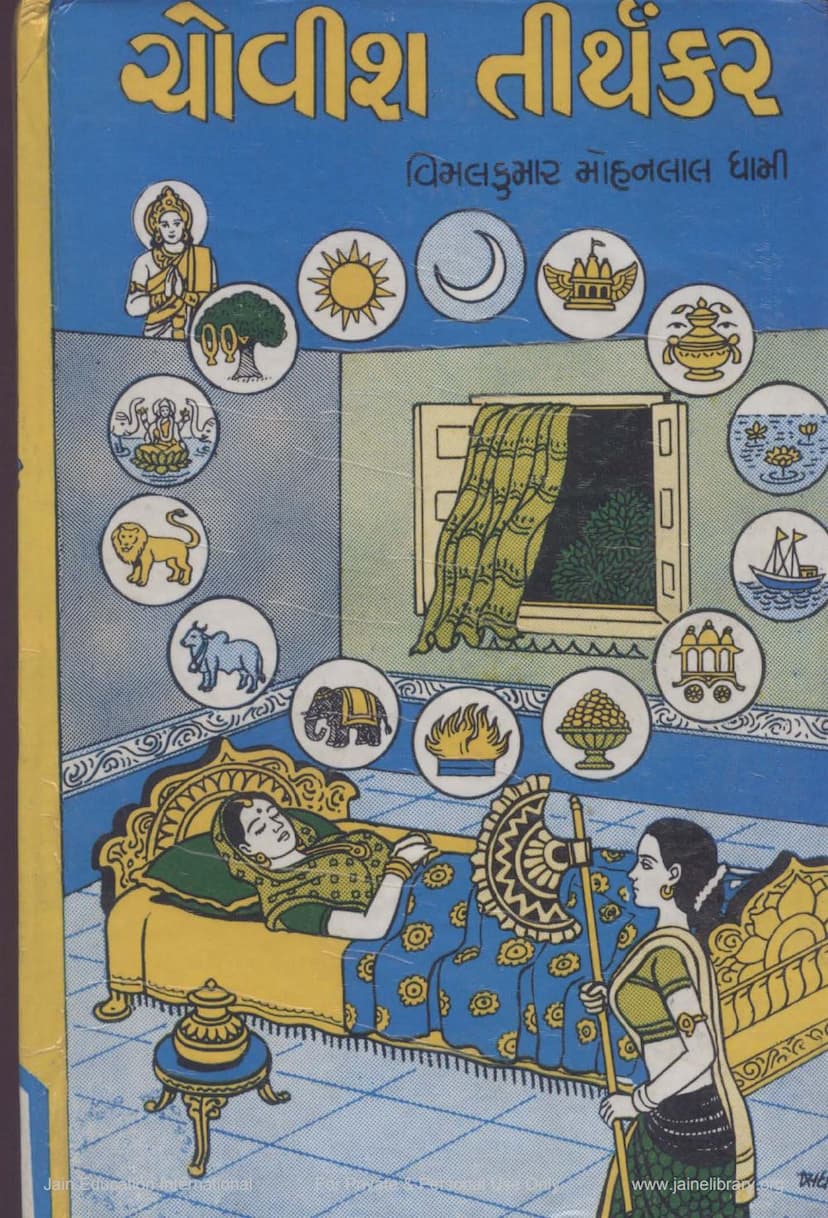Chovish Tirthankar
Added to library: September 1, 2025

Summary
The book "Chovish Tirthankar" by Vimalkumar Mohanlal Dhami, published by Navyug Pustak Bhandar, Rajkot, is a comprehensive work detailing the lives of the 24 Tirthankaras in Jainism. The catalog link provided, jainqq.org/explore/005243/1, suggests it is a valuable resource for Jain education.
The book begins by dedicating itself to Param Pujyapada Gurudev Acharyashri Yashodevsuri ji Maharaj, indicating a deep respect for spiritual guidance within Jain tradition. The author, Vimalkumar Mohanlal Dhami, is presented as a profound scholar, creator, researcher, and thinker in Jain literature, with an extensive list of his published works provided on page 5. These works cover a wide range of topics, including biographies of revered figures, historical accounts, and philosophical explorations, suggesting a prolific and dedicated author in the Jain literary sphere.
Key aspects covered in the book, based on the provided pages, include:
- The Inspiration and Genesis: The author was inspired by Shri Somchadbhai D. Shah, the founder editor of 'Sudhoka' magazine, to write about the lives of the 24 Tirthankaras. The author notes the scarcity of concise biographies of the Tirthankaras in Gujarati literature.
- The Core Textual Basis: The primary source for the biographies of the 24 Tirthankaras is acknowledged to be the "Shri Trishashti Shalaka Purush Charitra" by Acharya Shri Hemchandracharya Maharaj. This foundational text is described as an "amazing scripture" and a "complete history of Jain religion and culture," detailing the authentic lives of the 63 Shaka Purushas.
- Definition of Shaka Purusha: The book explains that Shaka Purushas are "excellent men" or those possessing "samyaktva" (right faith). These are virtuous souls who hold the "samyaktva-like rod" (samyaktva-rupi shalaka). The author quotes Acharya Shri Hemchandracharya's definition from his dictionary, "Abhidhan Chintamani," defining Shaka Purusha as the "most excellent among men created, existing, and to exist in the universe."
- Cyclical Time and Tirthankara Births: The text explains the Jain concept of time cycles, where each half-cycle has 63 Shaka Purushas.
- Author's Approach and Humility: Vimalkumar Mohanlal Dhami humbly states that his book is a modest attempt to chronicle the lives of the 24 Tirthankaras, acknowledging the difficulty of the task and deferring to the reader's judgment on his success. He also attributes any excellence in his work to Acharya Shri Hemchandracharya.
- Reader Reception and Editions: The book has seen multiple printings (third edition mentioned on page 3), indicating its popularity and the positive reception from Gujarati readers. The author expresses gratitude for the love and respect shown to his work.
- Detailed Biographies (Example of Adinath Swami): The initial pages (starting from page 10) begin the life story of Shri Rishabhdev Swami, the first Tirthankara. This section provides a rich narrative of his birth, celestial attendants (Dik-kumaris), the significance of his mother Marudevi's fourteen dreams (including a bull, elephant, lion, lotus, moon, sun, flag, pitcher, pond, ocean, aircraft, gem heap, and fire), his naming based on the first dream, the establishment of the Ikshvaku dynasty, the introduction of various arts and sciences (like 100 types of crafts, 72 arts for men taught to Bharat, and 64 arts for women taught to Bahubali), his marriage, the birth of his children (Bharat, Bahubali, Brahmi, Sundari, and 98 other sons), his reign, his renunciation, his immense charity, his ascetic practices, and his ultimate attainment of Nirvana. The detailed descriptions of the celestial ceremonies, the establishment of societal structures, and the profound spiritual journey highlight the epic nature of the Tirthankaras' lives.
- Subsequent Tirthankaras: Pages 34 onwards introduce the lives of the subsequent Tirthankaras, such as Shri Ajitnath Swami and Shri Sambhavnath Swami, following a similar pattern of narrating their birth, dreams, divine ceremonies, life events, renunciation, and ultimate liberation. Each biography is meticulously detailed, offering insights into the specific symbols (lachhan), lineage, parents, cities, significant dreams, and the lifespan of each Tirthankara.
- Astrology and Numerology: The inclusion of details like the specific constellations (nakshatra) during conception and birth, the influence of planetary positions (graha), and the use of specific mantras suggests a connection between Jain hagiography and astrological beliefs.
- The Structure of the Book: The table of contents on page 9 lists all 24 Tirthankaras, indicating a systematic and chronological presentation of their lives.
In essence, "Chovish Tirthankar" is presented as an authoritative and revered compilation of the lives of the 24 Tirthankaras, drawing from classical Jain texts and presented in a narrative style that makes these spiritual figures accessible and inspiring to readers. The author's dedication to the subject and the book's repeated editions signify its importance within Jain literature.